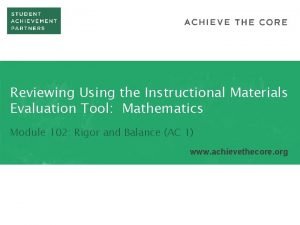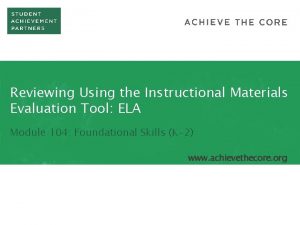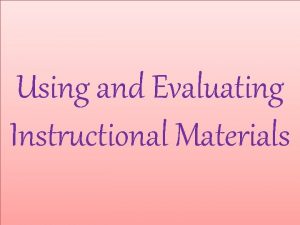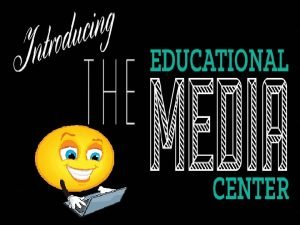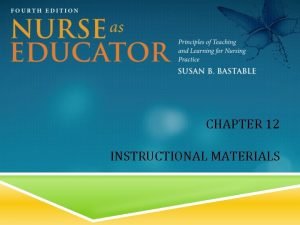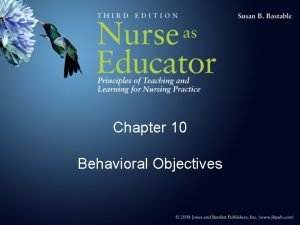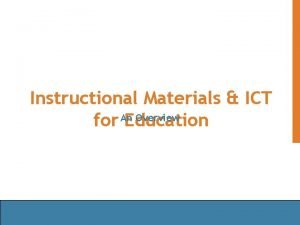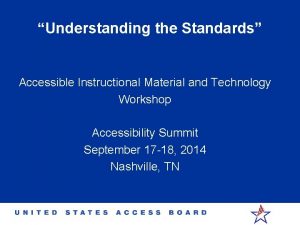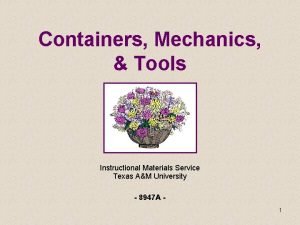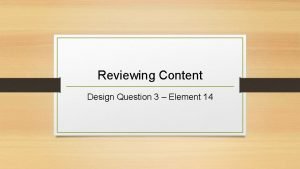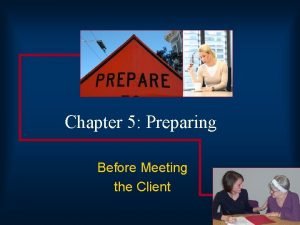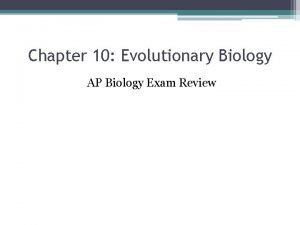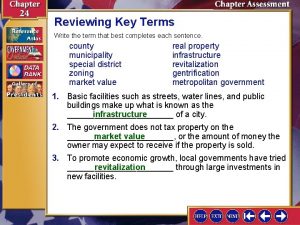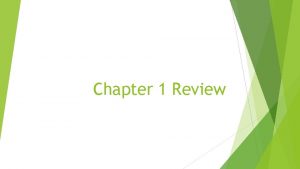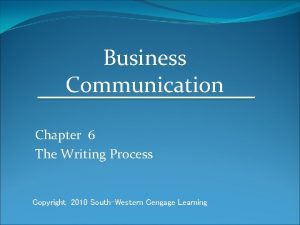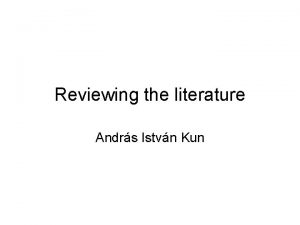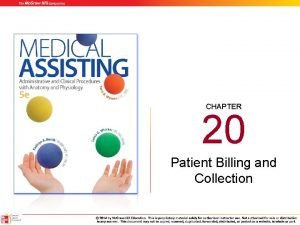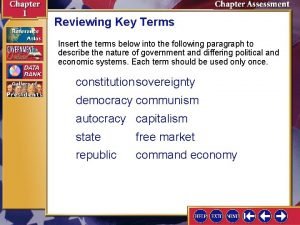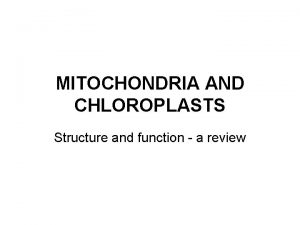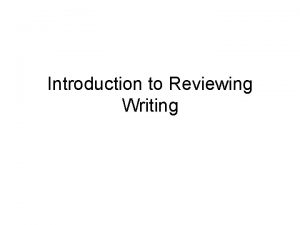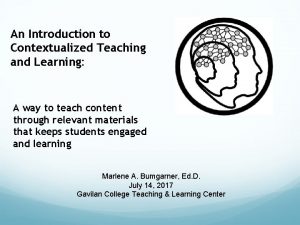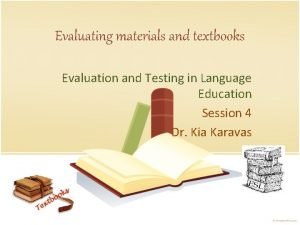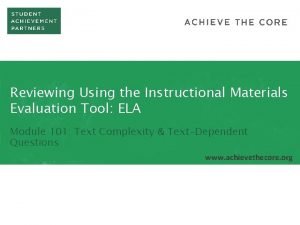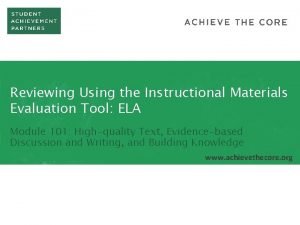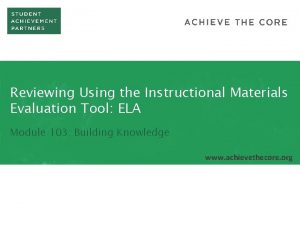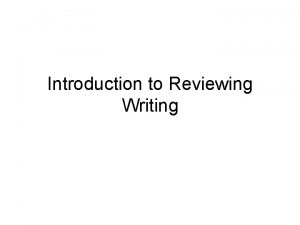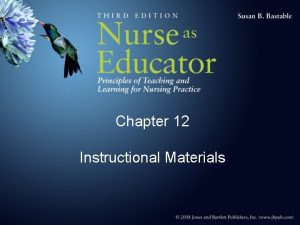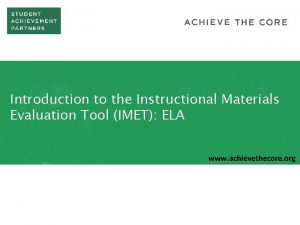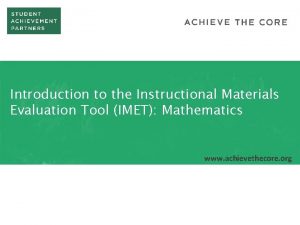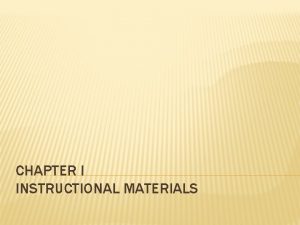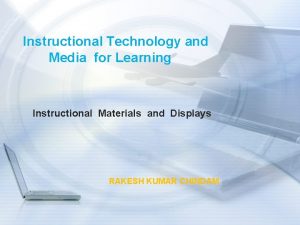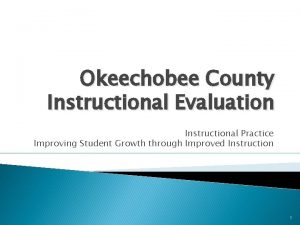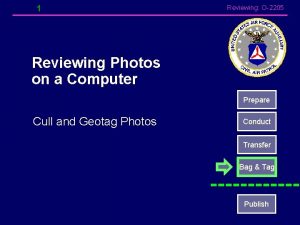Reviewing Using the Instructional Materials Evaluation Tool Mathematics



































- Slides: 35

Reviewing Using the Instructional Materials Evaluation Tool: Mathematics Module 102: Rigor and Balance (AC 1) www. achievethecore. org

Essential Questions • How does the Instructional Materials Evaluation Tool (IMET) reflect the major features of the Standards and the Shifts? • What understandings support high-quality, accurate application of the IMET metrics? PAGE 2

Goals • Understand how aligned materials embody the shifts inherent in the Common Core State Standards • Understand the precise meaning of each metric of the IMET • Recognize examples and non-examples related to each metric of Alignment Criterion 1 PAGE 3

Non Negotiable vs. Alignment Criteria Non- Negotiable Criteria Alignment Criteria Each metric rated Meets/Does Not Meet Each metric rated Meets/Partially Meets/Does Not Meet Every metric must be met to rate the criterion as Meets Must receive 5 out of 6 points to rate the criterion as Meets PAGE 4

Alignment Criterion 1: Rigor and Balance

Rigor Alignment Criterion 1: Materials must reflect the balances in the Standards and help students meet the Standards’ rigorous expectations. IMET p. 13 PAGE 6

What Is Rigor? PAGE 7

The Three-Legged Stool • PAGE 8

Conceptual Understanding AC Metric 1 A: The materials support the development of students’ conceptual understanding of key mathematical concepts, especially where called for in specific content Standards or cluster headings. IMET pp. 14 -15 PAGE 9

Conceptual Understanding • Teach more than “how to get the answer” and instead support students’ ability to access concepts from a number of perspectives • Students are able to see math as more than a set of mnemonics or discrete procedures • Conceptual understanding is about mathematical ideas, often distinct from context. • Conceptual understanding supports the other aspects of rigor (procedural skill and fluency, and application) PAGE 10

IMET p. 14 PAGE 11

AC 1 A: Where the Standards explicitly require students to understand concepts, do the assignments that students work on build that understanding and do assessment tasks reveal whether students understand the mathematics in question? 4. OA. A Use the four operations with whole numbers to solve problems. 4. OA. A. 1 Interpret a multiplication equation as a comparison, e. g. , interpret 35 = 5 × 7 as a statement that 35 is 5 times as many as 7 and 7 times as many as 5. Represent verbal statements of multiplicative comparisons as multiplication equations. 4. OA. B. 4 Find all factor pairs for a whole number in the range 1– 100. Recognize that a whole number is a multiple of each of its factors. Determine whether a given whole number in the range 1– 100 is a multiple of a given one-digit number. Determine whether a given whole number in the range 1– 100 is prime or composite. 4. MD. A. 3 Apply the area and perimeter formulas for rectangles in real world and mathematical problems. For example, find the width of a rectangular room given the area of the flooring and the length, by viewing the area formula as a multiplication equation with an unknown factor. IMET pp. 14 -15 Handout p. 2 PAGE 12

AC 1 A: Do the materials feature high-quality conceptual problems and conceptual discussion questions? [I]n solving problems, students learn new mathematics, whereas in working exercises, students apply what they have already learned to build mastery. Problems are problems because students haven’t yet learned how to solve them; students are learning from solving them. - K-8 Publishers’ Criteria, Spring 2013, p. 17 IMET pp. 14 -15 PAGE 13

AC 1 A: Do the materials feature high-quality conceptual problems and conceptual discussion questions? 4. NF. A IMET pp. 14 -15 Handout p. 3 PAGE 14

AC 1 A: Do the materials feature high-quality conceptual problems and conceptual discussion questions? 4. NF. C Which number is larger? 1. 7 or 17 twelfths Explain how you can tell without drawing a picture. IMET pp. 14 -15 Handout p. 3 PAGE 15

AC 1 A: Do the materials feature opportunities to identify correspondences across mathematical representations? IMET pp. 14 -15 Handout p. 4 PAGE 16

AC Metric 1 A: Review a Full Lesson - Review the grade 4 lesson on pp. 5 -8 of your handout. - Note evidence for each question associated with AC Metric 1 A on p. 15 of your IMET. - Discuss: -Gut check: Would these materials meet, partially meet, or not meet AC 1 A? What is your evidence? -What other things would you want to look at in these materials to determine your rating? PAGE 17

Procedural Skill and Fluency AC Metric 1 B: The materials are designed so that students attain the fluencies and procedural skills required by the Standards. IMET pp. 16 -17 PAGE 18

Procedural Skill and Fluency • The Standards require speed and accuracy in calculation. • Materials structure class time and/or homework time for students to practice core functions such as single-digit multiplication so that they are more able to understand manipulate more complex concepts PAGE 19

Required Fluencies in K-6 Grade Standard Required Fluency K K. OA. 5 Add/subtract within 5 1 1. OA. 6 Add/subtract within 10 2 2. OA. 2 2. NBT. 5 Add/subtract within 20 (know single-digit sums from memory) Add/subtract within 100 3 3. OA. 7 3. NBT. 2 Multiply/divide within 100 (know single-digit products from memory) Add/subtract within 1000 4 4. NBT. 4 Add/subtract within 1, 000 5 5. NBT. 5 Multi-digit multiplication 6 6. NS. 2, 3 Multi-digit division Multi-digit decimal operations PAGE 20

IMET p. 17 PAGE 21

AC 1 B: Is progress toward fluency and procedural skill interwoven with students’ developing conceptual understanding of the operations in question? IMET pp. 16 -17 Handout p. 9 PAGE 22

AC 1 B: Do the materials in grades K– 6 provide repeated practice toward attainment of fluency Standards? IMET pp. 16 -17 PAGE 23

AC Metric 1 B: Review a Full Lesson • Review the grade 4 lesson on pp. 10 -13 of your handout. • Note evidence for each question associated with AC Metric 1 B on p. 17 of your IMET. • Discuss: - Gut check: Would these materials meet, partially meet, or not meet AC 1 B? What is your evidence? - What other things would you want to look at in these materials to determine your rating? PAGE 24

Application AC Metric 1 C: The materials are designed so that teachers and students spend sufficient time working with applications, without losing focus on the Major Work of each grade. IMET pp. 18 -19 PAGE 25

Application • Students can use appropriate concepts and procedures for application even when not prompted to do so. • Teachers provide opportunities at all grade levels for students to apply math concepts in “real world” situations, recognizing this means different things in K-2, 3 -5, and 6 -8 PAGE 26

IMET p. 19 PAGE 27

AC 1 C: Are there single- and multi-step contextual problems that develop the mathematics of the grade, afford opportunities for practice, and engage students in problem solving? A grower packs 4, 568 peaches. He packs the most peaches possible, dividing them equally into 9 boxes, and then gives away the remaining peaches. • How many of the remaining peaches does he give away? • If he sells 7 boxes, how many peaches does he have left? IMET pp. 18 -19 Handout p. 14 PAGE 28

AC 1 C: Do application problems particularly stress applying the Major Work of the grade? 1) A clown needs 275 balloons for a party he is going to, but the balloons only come in packs of 8. How many packs of balloons does he need to buy? 2) A florist splits 878 flowers into vases by putting 9 flowers in each vase. She needs more flowers to fill the last vase. How many more flowers does she need so that the last vase also IMET pp. 18 -19 has 9? Handout p. 15 PAGE 29

AC 1 C: Does modeling build slowly across K– 8, with applications that are relatively simple in earlier grades and when students are encountering new content? In grades 6– 8, do the problems begin to provide opportunities for students to make their own assumptions or simplifications in order to model a situation mathematically? 2. OA. A. 1 A pencil costs 59 cents, and a sticker costs 20 cents less. How much do a pencil and a sticker cost together? 7. EE. B. 4 Shelbi is running in a half marathon today. About ½ hour before the race, she parks her car in a garage about ¼ mile from the starting line. The prices for parking are shown in the following table: Less than 1 hour $8 1 hour to less than 2 hours $12 2 hours to less than 3 hours $15 3 hours or more $18 As she is running, she remembers that she only has $13. What is the slowest pace IMET pp. 18 -19 Shelbi can run, in minutes per mile, and still pay less than $13 for parking? Explain Handout p. 16 your answer. State any assumptions you made. PAGE 30

AC Metric 1 C: Review a Full Lesson • Review the grade 4 lesson on pp. 17 -20 of your handout. • Note evidence for each question associated with AC Metric 1 C on p. 19 of your IMET. • Discuss: - Gut check: Would these materials meet, partially meet, or not meet AC 1 C? What is your evidence? - What other things would you want to look at in these materials to determine your rating? PAGE 31

IMET p. 24 PAGE 32

Wrapping Up

Alignment Criterion 1 and Metrics AC #1: Balance and Rigor • 1 A: Conceptual Understanding • 1 B: Procedural Skill and Fluency • 1 C: Application PAGE 34

Essential Questions -- Discuss • How does the Instructional Materials Evaluation Tool (IMET) reflect the major features of the Standards and the Shifts? • What understandings support high-quality, accurate application of the IMET metrics? PAGE 35
 Instructional materials evaluation tool
Instructional materials evaluation tool Evaluation tool for instructional materials
Evaluation tool for instructional materials øis
øis Education media center
Education media center Visual instructional materials
Visual instructional materials Instructional materials examples
Instructional materials examples Technique definition
Technique definition Heograpiya ng boracay
Heograpiya ng boracay Instructional materials in ict
Instructional materials in ict Sepal structure
Sepal structure Examples of accessible instructional materials
Examples of accessible instructional materials Invisibility
Invisibility Instructional materials service
Instructional materials service Kinds of instructional materials
Kinds of instructional materials Instructional materials service
Instructional materials service Chapter 5 the minor parties
Chapter 5 the minor parties Reviewing content marzano
Reviewing content marzano Preparatory reviewing
Preparatory reviewing Reviewing key concepts reproductive barriers
Reviewing key concepts reproductive barriers Reviewing key terms
Reviewing key terms Reviewing concepts and vocabulary chapter 1
Reviewing concepts and vocabulary chapter 1 What is writing process in business communication
What is writing process in business communication Febabook
Febabook Chapter 20 patient collections and financial management
Chapter 20 patient collections and financial management Section 4 flatworms mollusks and annelids
Section 4 flatworms mollusks and annelids Reviewing key terms
Reviewing key terms Structure and function of mitochondria
Structure and function of mitochondria What is reviewing
What is reviewing Contextualized learning
Contextualized learning Using mathematics and computational thinking
Using mathematics and computational thinking Evaluation of materials books
Evaluation of materials books Cant stop the feeling trolls go noodle
Cant stop the feeling trolls go noodle How would you differentiate useful from harmful materials
How would you differentiate useful from harmful materials Natural man made
Natural man made What is adopting materials
What is adopting materials Direct materials budget with multiple materials
Direct materials budget with multiple materials
